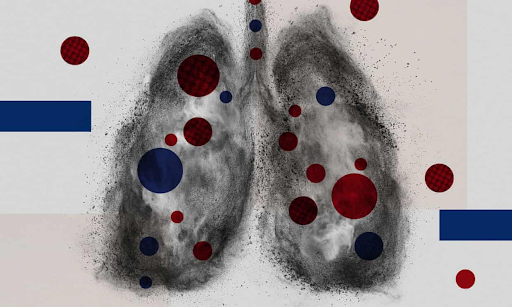Does Air Pollution Impact COVID-19 Mortality
Shrushti S. Patil
 Illustration by Guardian Design
Illustration by Guardian Design
This article focuses on the air pollution aspect which influences COVID-19 mortality rate. It sheds light on how even a minor increase in the number of harmful air pollutants can exacerbate COVID-19's damaging consequences.
Tweet
The world has been in the grip of the COVID-19 pandemic situation for a while now. The novel Coronavirus (SARS-CoV-2), was first discovered in December of 2019. It emerged in a wet market in China’s Wuhan, where it may have spread species from another mammal to humans. Considering a case study of England, to date, over 4,467,310 instances of COVID-19 have been tabulated and more than 127,739 patients have succumbed to it. Fortunately, we have progressed in managing this disease to some extent.
With all the latest stories regarding COVID-19, researchers at the University of Cambridge have made fascinating findings. Marco Travaglio and his group found a correlation between air pollution and the COVID-19 deaths in the beginning phase of this pandemic. Their study found that a minute increase in air pollution causes COVID-19 to spread and claim more lives. Further investigation suggests that exposure to air pollution for long durations may enhance the severe effects of COVID-19.
 Figure: Hypothesis of the SARS-CoV-2 infection mechanisms and severe lung disease induced by the combined effect of PM 2.5 and NO2.
Figure: Hypothesis of the SARS-CoV-2 infection mechanisms and severe lung disease induced by the combined effect of PM 2.5 and NO2.
Human activities such as transportation, industrial processes, and mining have increased the levels of many harmful pollutants. For instance, it is true that prolonged exposure to common road transport pollutants, including nitrogen oxides and ground-level ozone, can induce oxidative stress and inflammation within the airways. This situation significantly aggravates health conditions such as asthma, chronic obstructive pulmonary disease, cardiovascular diseases, and diabetes. Consequently, air contamination has been recommended to add to COVID-19 seriousness, either straightforwardly, by compromising the lungs' immune response to the infection, or indirectly, by exacerbating underlying respiratory or cardiovascular diseases.
For this, originally researched possible connections were investigated between regional and sub-regional variations in air pollution, population level, COVID-19-related deaths cases in England, and data was retrieved from the National Health Service (NHS). Three significant air pollutants were considered, namely, nitrogen dioxide, nitrogen oxide, and ozone, across the seven regions in England to determine the relationship between COVID-19 deaths cases.
To demonstrate this, Pozzer and his colleagues used satellite data to define fine particle exposure and estimated the anthropogenic component using an atmospheric chemistry model. The extent to which air pollution influences COVID-19 mortality was determined using epidemiology data from the United States and China. Epidemiology reveals the incidence, distribution of the disease. Based on this, they projected that air pollution contributed roughly 15% of COVID-19 mortality overall, 27% in East Asia, 19% in Europe, and 17% in North America.
Nitrogen oxides are the principal supporter of expanded quantities of COVID-19 deaths in the early phase of the pandemic. The analysis identified fine particulate matter as significant predictors of increased SARS-CoV-2 infectivity. In light of the results, it was seen that a small increase in the long-term average of nitrogen dioxide levels increased COVID-19 cases by 4.5%. Similarly, an increase in nitrogen oxides was associated with approximately 2% increased cases in England. On the other hand, ozone levels are not significant predictors of infectivity.
 Credits: Spyarm, istockphoto
Credits: Spyarm, istockphoto
Exposure to these pollutants may inhibit pulmonary antimicrobial responses, reducing clearance of the virus from the lungs and promoting infectivity. Reduced phagocytic function (ingestion of foreign body particles) is well documented after the exposure of the virus to particulate matter which can be the mechanism that enhances viral infection. Utilising all the details it shows that fine particulate matter was a significant supporter of COVID-19 cases in England.
 Credits: Cottonbro, Pexels
Credits: Cottonbro, Pexels
Bibliography
Shrushti S. Patil is a Space Microbiologist. She has a Bachelor's degree in Environmental Sciences and has pursued a Master's in Biodiversity. Nature has always piqued her curiosity. She also enjoys playing cricket.
signup with your email to get the latest articles instantly